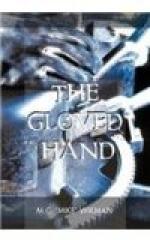“Well,” answered Godfrey, smiling, “science isn’t able, as yet, to identify the blood of individuals; but I’d be willing to give odds that it’s Swain’s blood. My idea is that Silva got the blood for the finger-prints from the blood-soaked handkerchief, which Swain probably dropped when he fled from the arbour, and which Silva picked up and dropped beside the chair, after he was through with it, as an additional bit of evidence.”
“That’s reasonable enough,” agreed Hinman, with a quick nod, “but what I can’t understand is how he made these reproductions.”
Godfrey sat down again and contemplated the glove pensively for some moments. Then he turned to me.
“Where is that book of finger-prints you spoke about, Lester?” he asked.
I went to the book-case and got it out. Godfrey took it and began to turn the pages quickly.
“Swain’s name is in the index,” I said, and he glanced at it, and then turned to the place where the page had been.
“Which reminds me,” said Hinman, with a rueful smile, “that I concocted a very pretty theory to account for that missing page. I felt quite chesty about it! I’m glad it didn’t throw Miss Vaughan off the scent!”
“So am I!” agreed Godfrey, “for it must have been this missing page which gave Miss Vaughan her first suspicion of the truth. Perhaps it was pure inspiration—or perhaps she knew that Silva could reproduce finger-prints. We shall learn when we hear her story. In any event, it’s a clever trick—and easy enough when you know how!”
“Like standing the egg on end,” I suggested.
“Precisely. Every trick is easy when you work it backwards. But just think, Simmonds,” he added, “what problems the police will have to face, if gloves like these become fashionable among cracksmen!”
Simmonds groaned dismally.
“You haven’t told us yet how it’s done,” he said.
I bit back a smile, for Simmonds’s tone was that of pupil to master.
“Well,” said Godfrey, slowly, “it might be done in several ways. The first thing is to get a good set of the prints to be reproduced. That Silva got from this album. The moulds might be made by cutting them in wood or metal; but that would take an expert—and besides, I fancy it would be too slow for Silva. He had a quicker way than that—perhaps by transferring them to a plate of zinc or copper and then eating them out with acid. Once the mould is secured, it is merely a question of pressing india-rubber-mixture into it and then heating the rubber until it hardens—just as a rubber-stamp is made. The whole process would take only a few hours.”
Simmonds drew a deep breath.
“It may be simple,” he said, “but that fellow’s a genius, just the same. He’s much too clever to be at large. We’ve got to get him!”
“Be sure of one thing,” retorted Godfrey. “You’ll find it harder to catch him than it was to let him go! He won’t walk into your arms. Not that I blame you, Simmonds,” he added; “but I blame those muckle-headed men of yours—and I blame myself for not keeping my eyes open. Here’s the glove—take good care of it. It means Swain’s acquittal. And now there is one other thing I want to see before we go to bed. Suppose we make a little excursion to the roof.”




